|
Walking Away
Into the Arms of Our Mother
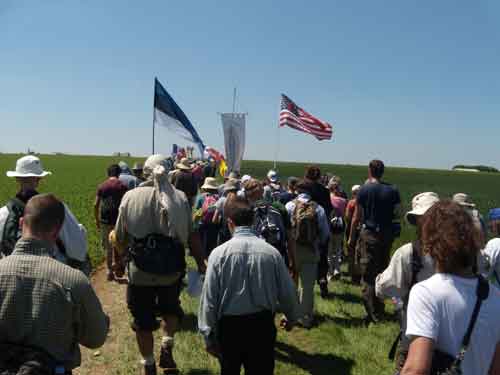
U.S. Chapter on the 2010
Pilgrimage to Chartres
Michael J. Matt
Editor, The Remnant
An Unlikely Chartres
Pilgrim
Charles Péguy:
Revived the Chartres Pilgrimage in 1913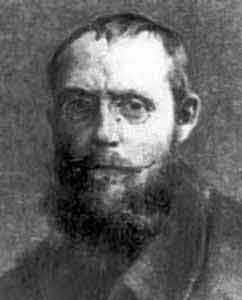
(Posted
06/17/10
www.RemnantNewspaper.com) For a good part of his
life Charles Péguy (1873 – 1914), the great French poet, was
an ardent socialist and an on-again, off-again agnostic.
Before his death on the battlefield in the early days of
World War I, he’d become a believer whose conversion though
never exploited for personal gain, had been met with shocked
disbelief by France’s literary community.
For Péguy, however, his
was not a conversion so much as part of the natural
maturation process which for all truly honest men included
coming to terms with the only Truth there is—the Truth of
Christ. His coming to terms with the Catholic Faith was a
lonely and often turbulent flight that manifested itself to
the world below through some of the most soul-stirring and
provocative French-language poetry of the 20th century.
Though he’d long since
become a believer it wasn’t until Péguy found himself on the
battlefield that he resolved to fully return to the
Sacraments. Nevertheless, so compelling was his written
record of transformation from agnostic to believer that when
word of his death reached T. S. Eliot the great
English-language poet mourned “one of the most illustrious
of the dead who have fallen in this war.”
Péguy is no plaster
saint, however, and his journey into the light is not
without long and extended dark nights. Throughout his life,
in fact, his soul seems to have remained riddled with bullet
holes from countless skirmishes with adversaries first to
the right and then to the left. Even after his conversion he
remained among the walking wounded of post-Revolution
“enlightened” France, ever searching for a way back home. As
one writer put it, “Péguy seems to have come to an
understanding through his experience that pain and even a
vulnerability to sinfulness often are the only ways to open
up channels by which real grace can reach us, particularly
those of us who think our faith and morals are already
enough.”
Not surprisingly, the
notion of Catholic pilgrimage emerges as integral to the
struggle of Charles Péguy, so much so in fact that this
passionate and often volatile personality practically single
handedly breathed life back into what had come to be
regarded as an outmoded “medieval ritual”. Had it not been
for Péguy it is highly unlikely that the Chartres Pilgrimage
would have survived the attempted purging of all things
Catholic which took place in Europe from World War I to the
present.
His son Marcel had fallen
deathly ill and, rather than giving in to easy despair,
Péguy placed his son in the hands of the Blessed Virgin Mary
before literally “walking away” – vowing to retrace the
ancient pilgrim’s path from Paris to Chartres when his son
regained his health.
Marcel recovered, of
course, and his father was true to his word, walking from
Notre-Dame de Paris to Notre-Dame de Chartres not once but
several times before his death two years later. Through the
process of physical pilgrimage the warrior poet evidently
sought to earn the right to lay claim to the Faith he’d once
strained against. Pious platitudes and easy creeds were not
the stuff of Charles Péguy. He was a soldier and a poet, but
not a saint. And, as such, the notion of pilgrimage appealed
to his warrior heart.
Inspired by his example
if baffled by his conversion, friends tracked Péguy along
his newfound pilgrim’s path. And after his death when his
popularity began to dramatically increase, admirers from all walks began
yearning to retrace the footsteps not only of Joan of Arc
and St. Louis IX, but also of Charles Péguy over the plain
la Beauce, through the forests near Choisel, and into the
mysterious sanctuary of Notre-Dame de Chartres where Péguy
had surrendered his cold rationalism at the altar of Faith
in the ‘playhouse of Our Lady’. Here the sophisticated man
of letters shocked the world by humbly declaring himself
“subject to the Virgin of Chartres.” And all Paris gasped!
In the Footsteps of Péguy
American pilgrims assist
their 'walking wounded'
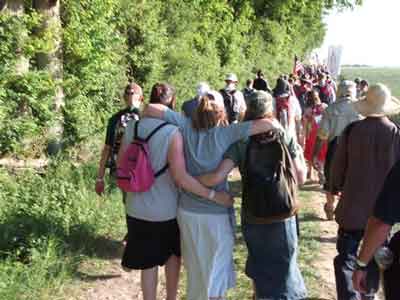 In
May of 2010, this writer crossed the Atlantic to walk in the
footsteps of saints and sinners on that same pilgrimage to
Chartres. Between ten and fifteen thousand Catholics from
all over Europe devoted three days and two nights to
“walking away” from a world well beyond human hope.
Following Péguy’s lead, they placed their future not
partially but entirely in the hands of the Mother of God,
Notre-Dame d’Esperance. Why? Because like Péguy’s Marcel,
our children too are dying at least in the sense that their
little souls are under constant assault from those who would
sooner see them dead than Catholic. In
May of 2010, this writer crossed the Atlantic to walk in the
footsteps of saints and sinners on that same pilgrimage to
Chartres. Between ten and fifteen thousand Catholics from
all over Europe devoted three days and two nights to
“walking away” from a world well beyond human hope.
Following Péguy’s lead, they placed their future not
partially but entirely in the hands of the Mother of God,
Notre-Dame d’Esperance. Why? Because like Péguy’s Marcel,
our children too are dying at least in the sense that their
little souls are under constant assault from those who would
sooner see them dead than Catholic.
Like Péguy’s, our world
is also on the brink of total war, perhaps literally, but
certainly morally and spiritually and against all things
Christian.
Like Péguy, an increasing
awareness of our own mortality and sinfulness, coupled with
a universal dereliction of duty by the majority of our
shepherds who would otherwise lead us into the light, lends
urgency to the effort to personally come to terms with God
while there is still time.
Like Péguy, the pilgrims
are the furthest thing from perfection which is why on an
eve of yet another world war they recognize no better means
of saving their souls and serving their homeland than
falling to their knees before the Mother of God and begging.
Everything else has been
tried and everything else has failed. Elections, like
politicians, come and go but amount to nothing more than a
revised cast of characters with essentially the same utopian
agenda. An armada of Tea Partiers wrapped in a hundred
thousand American flags could take to the high seas tomorrow
and their cause would remain lost. It’s too late for that.
The enemies of Christ control every aspect of our lives—from
education to entertainment and from finance to personal
freedom; indeed, even our protests are permitted by leave of
our jailers.
Rising taxes and broken
borders should be the last concern of a civilization
defending itself not against flesh and blood, but against
principalities and power, against the rulers of the world of
this darkness, against the spirits of wickedness in the high
places.
One doesn’t vote demons
out of office. Ever since the Enlightenment this war has
always been fundamentally anti-Christian, against the Word
of God, His Scripture, His Tradition, His Church. The way to
engage this evil enemy is to take up the pilgrim’s staff and
walk away, place trust in God rather than men, learn to home
school our children, rediscover how to live off the land
while worshipping God as our fathers did, and place our hope
entirely in the Queen Mother of Christ the King. There is
no other way.
The Church is Our Mother
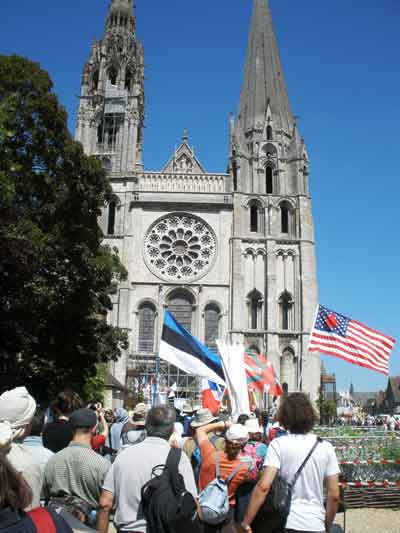 The
theme of this year’s Pilgrimage to Chartres was L’Eglise Est
Notre Mere” (The Church is Our Mother). Over the past
nineteen years since first I walked it, I’ve often employed
the military metaphor of “going to war” in an effort to
describe what it is like to fall in with 15,000 pilgrims and
walk for three days across France. But this is not entirely
accurate, at least not as I now see it. The pilgrim setting
out at sunrise from Notre-Dame in Paris sees his destination
– the Cathedral of Notre-Dame in Chartres, some 70 miles and
3 days hence – not as the frontline but rather as the
furthest thing from it. He is not advancing toward the enemy
at Chartres, but rather like a modern Odysseus he moves
through his Catholic odyssey with his eyes constantly
scanning the horizon for a first glimpse of home. The spires
of Chartres even in faint and distant view become the
outstretched arms of his mother, waiting to embrace her
returning soldier sons. The
theme of this year’s Pilgrimage to Chartres was L’Eglise Est
Notre Mere” (The Church is Our Mother). Over the past
nineteen years since first I walked it, I’ve often employed
the military metaphor of “going to war” in an effort to
describe what it is like to fall in with 15,000 pilgrims and
walk for three days across France. But this is not entirely
accurate, at least not as I now see it. The pilgrim setting
out at sunrise from Notre-Dame in Paris sees his destination
– the Cathedral of Notre-Dame in Chartres, some 70 miles and
3 days hence – not as the frontline but rather as the
furthest thing from it. He is not advancing toward the enemy
at Chartres, but rather like a modern Odysseus he moves
through his Catholic odyssey with his eyes constantly
scanning the horizon for a first glimpse of home. The spires
of Chartres even in faint and distant view become the
outstretched arms of his mother, waiting to embrace her
returning soldier sons.
For modern men, the
frontline is everyday life in the “real world” which is
waging total war against Christ. Chartres is the reprieve, a
place where soldier becomes pilgrim for a short while in
order to heal and restore his soul before returning to the
front.
We were praying the
Rosary when I saw her for the first time this year. I heard
the voice of a young man from the front of our chapter shout
out: “There she is! Look there, the spires of Chartres.”
I looked up and was
surprised to find the words of the Hail Mary inexplicably
caught in my own throat. I couldn’t speak as tears,
astonishingly enough, filled my eyes. Why? I’m not sure.
Because l’Eglise est notre mere, I suppose, and the
sight of her even far off on the horizon offered welcome
promise of home. An aching, longing for the embrace of
Mother Church became tangible just then, even despite the
sex scandals, the crisis in the liturgy, and that illusive
figure of Despair that’s always lurking in the shadows,
never sleeping, never resting.
Along the road to
Chartres, Despair doesn’t have a chance. A child praying, an
old man confessing, a young priest in cassock can, in an
instant, transform the doubting pilgrim into a champion of
the Catholic order. The vision of a cathedral in the
distance after days on the road to Chartres can make even
the most jaded pilgrim yearn to lay down his life for
Christ’s Bride. On the road to Chartres chivalry is also
restored and the faithful soldier of Christ is born again.
A Shepherd in the Camp
Cardinal Vingt-Trois surrounded by 10,000 pilgrims
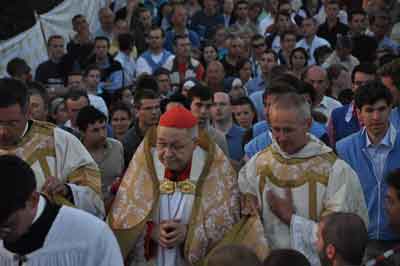 On
the second night of the Pilgrimage this year the pilgrims
had a chance to experience this phenomenon for themselves. On
the second night of the Pilgrimage this year the pilgrims
had a chance to experience this phenomenon for themselves.
There was more excitement
than I’d ever seen as the American chapter of some 65
pilgrims made its way down the steep embankment into the
camp. Exhausted and parched after two days beneath a
merciless sun, all we wanted to do really was find our tent
and fall to the ground. But a throng of French pilgrims
blocked our way, their jubilant song rising up before us
like the tide at sea.
All at once I heard my
own name being shouted by several Frenchmen just ahead. As
leader of the U.S. chapter I was being summoned. But why?
I made my way through the
bedlam and soon understood. The Cardinal Archbishop of Paris
himself was standing at the gate, greeting each chapter as
the miles-long column of pilgrims entered the camp. Head to
toe in traditional red, His Eminence was being hailed like a
victorious general by battle-weary troops.
Ju-bi-late Deo,
jubi-la-te Deo, Al-le-lu-ia
the scouts shouted in
thunderous
song
as they surrounded their “general”, scrambling to kneel for
his blessing as they passed.
A few moments later I
found myself kneeling at the feet of André Armand Cardinal
Vingt-Trois. As I kissed his ring, I recalled that His
Eminence is not known for being particularly supportive of
the Traditionalist cause in France. But out of respect for
his office and for the opportunity to show their shepherd
the true face of Tradition, the organizers of the
pilgrimage, Notre-Dame de Chrétienté, had invited the
Cardinal to visit the camp that night and offer Benediction
of the Blessed Sacrament for the pilgrims.
Graciously, the Cardinal
had accepted the invitation, and there he was, not in the
sanctuary of some elaborate cathedral, but standing in the
tall grass beneath the blazing sun, smiling and blessing his
dust-covered children.
As I briefly spoke to him
about what the Pilgrimage means to American Catholics and
how hundreds of us over the years have crossed the Atlantic
to take part in this glorious event, he smiled warmly and
gave me his blessing. Was it wishful thinking on my part or
did I detect something in his eyes that bespoke a profound
impact of what he saw unfolding before him. After all, only
a faithless man with a heart of stone could have beheld that
youthful army of Catholics, stretching back as far as the
eye could see, their flags and banners snapping in the
breeze, the heavy statues of Our Lady carried all the way
from Paris on the shoulders of scouts—and not been moved by
it. Cardinal Vingt-Trois didn’t strike me as either
stonehearted or faithless. I believe what he saw that day
made an impression that will not soon be forgotten.
Either way, as the sun
set and shadows grew long over the Bivouac de Gas, a Prince
of the Catholic Church parted a massive sea of pilgrims and
made his way to a traditional altar erected beneath the
stars. When he raised the monstrance a short while later and
the consecration bells sounded across the encampment, ten
thousand pilgrims crossed themselves and worshipped God in
absolute silence.
For that moment at least
Christus vincit and the Cardinal’s politics mattered
not one iota. The pilgrim army had become little children
again, praying at the feet of their father while swearing
allegiance to their Mother and worshipping their God.
It was as if the
revolution had never happened and the whole world was
Catholic again. The Cardinal was no longer Vingt-Trois but
rather he was Andrew, James, John, Thomas, Philip, Simon and
Jude. And the Catholic heart leapt with joy.
Little Miracles
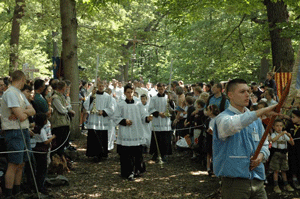 A
Jewish American journalist walked with the U.S. Chapter of
Our Lady of Guadalupe this year. He wanted to see for
himself before writing about the phenomenon that is the
widespread revival of Catholic pilgrimage in France.
Something happened to him along the way, however, that is
perhaps difficult to understand for those who’ve never
walked to Chartres. Our friend saw the face of Christ, not
just at the traditional Latin Masses in the
woods
or even in the ancient cathedrals on either end of the
pilgrim path; but rather in the face of a child. A
Jewish American journalist walked with the U.S. Chapter of
Our Lady of Guadalupe this year. He wanted to see for
himself before writing about the phenomenon that is the
widespread revival of Catholic pilgrimage in France.
Something happened to him along the way, however, that is
perhaps difficult to understand for those who’ve never
walked to Chartres. Our friend saw the face of Christ, not
just at the traditional Latin Masses in the
woods
or even in the ancient cathedrals on either end of the
pilgrim path; but rather in the face of a child.
As he later recounted the
story to us, he’d been limping along on failing knees and
was really hobbled by blisters that had long since been
covered over by still more blisters, when he realized that
going on much longer was impossible. Try as he did, nothing
could distract him from the thousand needles that were
stabbing into his flesh with every step.
“This is it,” he said to
himself. “I can go no further,” and that’s when he noticed
the little French scout from Riaumont falling back from her
chapter but limping manfully along. Her big boots and the
hem of her skirt gave muddy evidence of how faithfully this
littlest pilgrim had trudged the road to Chartres. And just
as our friend was about to surrender to the rigors of
pilgrimage and the blazing sun, she turned back to him,
smiled bravely and said: “Courage, Monsieur. Courage!”
That was all she said but
that was all she needed to say. “Such compassion in the eyes
of a child and for a perfect stranger,” our friend
recounted. “‘Courage’ she said to me, ‘Courage.’”
Our friend finished the
Pilgrimage on blisters I suspect were filled with blood,
tears of joy streaming down his face. If he is not a
Catholic by now I am confident he will be before the
pilgrims assemble at Notre-Dame next year. The scout from
Riaumont will surely not be the sole reason for his
conversion, but that she will be remembered by him—always—as
a prompting special grace, I have no doubt.
If there is one message
the Pilgrimage to Chartres broadcasts to the whole Catholic
world today it may indeed be one so simple even a child can
understand it: Courage! This dark night can not last
forever. Or, as Charles Péguy himself shouted to his
brothers in arms moments before he breathed his last on the
battlefield, “For God’s sake, push ahead.” Indeed, for God’s
sake, lets all push ahead. Courage!
Thanks and Looking to Next Year
U.S. Chapter of Guadalupe
2010 Pilgrimage to Chartres
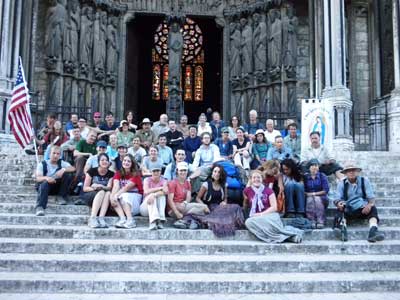 The
Pilgrimage, like all good things, came to an end in
Notre-Dame de Chartres on Pentecost Monday. Eight thousand
pilgrims packed the cathedral, and another five or six
thousand filled the square outside. In one voice the massive
assembly of Catholics brought it to a glorious conclusion
with, what else,
Christus vincit, Christus regnat,
Christus imperat—the triumphal hymn to Christ the King
which, by the way, was being sung that same day in Paris by
another 5,000 traditional Catholics who’d just finished
walking from Chartres to Paris on the “other pilgrimage”,
organized by the Society of St. Pius X. That makes nearly
20,000 Catholics on the road to and from Chartres over
Pentecost weekend 2010. The secular newspaper in Chartres
reported that representatives of the two pilgrimages had
designated a meeting place halfway between Chartres and
Paris where they could meet, raise a glass and offer each
other bon pelerinage! All hope is lost? I think
not! The
Pilgrimage, like all good things, came to an end in
Notre-Dame de Chartres on Pentecost Monday. Eight thousand
pilgrims packed the cathedral, and another five or six
thousand filled the square outside. In one voice the massive
assembly of Catholics brought it to a glorious conclusion
with, what else,
Christus vincit, Christus regnat,
Christus imperat—the triumphal hymn to Christ the King
which, by the way, was being sung that same day in Paris by
another 5,000 traditional Catholics who’d just finished
walking from Chartres to Paris on the “other pilgrimage”,
organized by the Society of St. Pius X. That makes nearly
20,000 Catholics on the road to and from Chartres over
Pentecost weekend 2010. The secular newspaper in Chartres
reported that representatives of the two pilgrimages had
designated a meeting place halfway between Chartres and
Paris where they could meet, raise a glass and offer each
other bon pelerinage! All hope is lost? I think
not!
So now it’s back to the
front-- the blisters, rocky ground, damp sleeping bags,
meager soup, hard bread and endless walking having again
become a happy memory of the grand adventure, the Pilgrimage
to Chartres, a sort of porthole to a world where priests
still pray their daily Office, children still obey their
parents, men are still men, women still women, tattoos and
body piercing nonexistent, iPods out of the question, Masses
in Latin, Saints revered, Mary is Queen, Christ is King, and
Faith, Hope and Charity reign supreme. Fifteen thousand
pilgrims experienced this glorious “Catholic thing” and now
have become fifteen thousands ambassadors bringing word of
it back to their homes and communities all around the world.
The U.S.
Chapter
of Our Lady of Guadalupe
Empress of the Americas was one of the largest ever. Mostly
young traditional Catholics from all over the States, they
formed a model chapter filled with good spirit, happy
singing, prayerful attentiveness, and enough camaraderie to
make three long days of pilgrimage pass by all too quickly.
Many thanks to all the
American pilgrims, young and old, for making the 2010
Pilgrimage one of the most memorable of the nineteen
organized thus far by Remnant Tours. And many thanks to
Remnant readers who sponsored 15 young Catholic pilgrims
who, as far as this writer is concerned, are the pride of
the Catholic Church in America, a credit to their parents,
and excellent spokesmen for the home school (and small
traditional Catholic school) movement in America.
Special thanks also to
Remnant Tour guides and chaperones who gave of themselves so
generously not only during the pilgrimage, but also during
the tour to Konnersreuth, Regensburg, Salzburg and Munich.
John Rao, Jamie Bogle, Christopher Ferrara, Mrs. Joan Mahar,
Mrs. Jane Latz—thank you for keeping the pilgrims safe,
informed and I hope inspired to take back the world for
Christ.
A special word of
gratitude also to our indefatigable chaplain, Fr. Jared
McCambridge, FSSP. The former Navy helicopter pilot turned
traditional Catholic priest was at every stage of the
pilgrimage nothing short of a walking inspiration. If Father
McCambridge is indicative
of the sort of formation and priestly caliber of the men
being ordained for the Fraternity of St. Peter, there is
every reason for all of us to be supremely confident that
the Catholic cause is headed for total victory. We are
humbled and honored to have had such a fine priest as our
chaplain.
Heartfelt thanks to our
French allies at
Notre-Dame de Chrétienté for organizing
what most now consider the premier annual event taking place
in the traditional Catholic world today. My friend, Herve
Rolland, the newly-elected president of Notre-Dame de
Chrétienté, deserves congratulations for organizing one of
the best pilgrimages thus far. God willing, we’ll join our
French brothers again next year.
Speaking of next year,
the dates of the Remnant Pilgrimage are June 8 thru June 19,
2011. This will be the 20th Anniversary of The Remnant
Chapter of Our Lady of Guadalupe. The itinerary has not yet
been established but will include the Notre-Dame de
Chrétienté Pilgrimage to Chartres followed by, hopefully,
the south of France, a couple of nights in Lourdes and
perhaps a day-long European Remnant Forum at the holy shrine
of Notre-Dame du Laus situated high in the beautiful French
alps. In any event, please look for our ads here in The
Remnant in October. We hope to see you on the road to
Chartres in 2011. |
